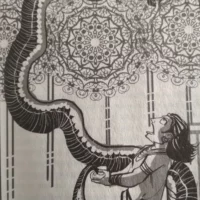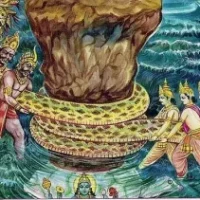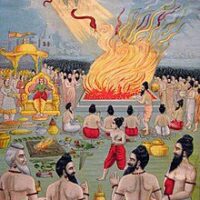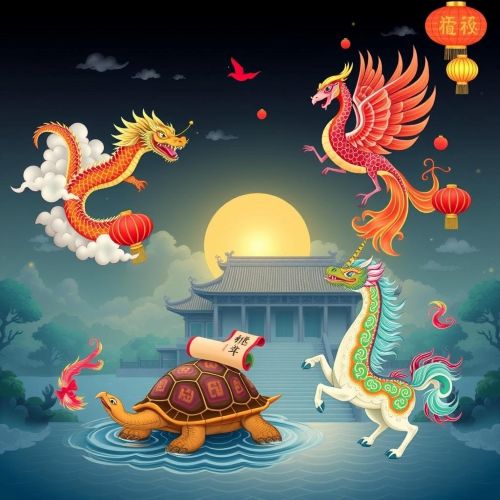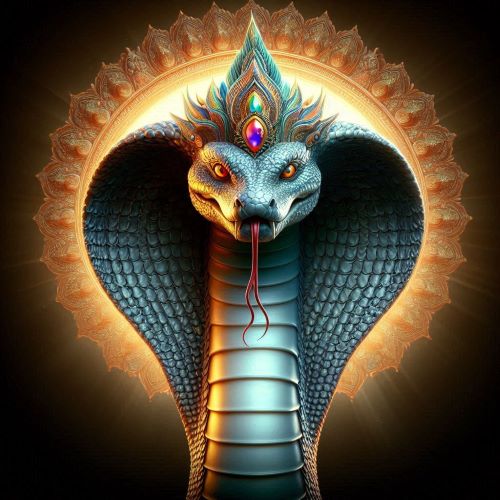Takshaka : The Serpent King
Listen
At a glance
| Description | |
|---|---|
| Origin | Indian Mythology |
| Classification | Animals |
| Family Members | Kadru (Mother) |
| Region | India |
| Associated With | Nagas, Underworld, Flight, Strength |
Takshaka
Introduction
Takshaka is a significant figure in Indian mythology, renowned as a powerful serpent king featured in ancient epics like the Mahabharata and various Puranic texts. As a naga, or serpent deity, he is depicted with great majesty and strength, wielding considerable influence over both the divine and mortal worlds. Takshaka’s narrative is marked by themes of vengeance and divine retribution, prominently highlighted by his role in the death of the sage Parikshit, which underscores the epic’s broader themes of curses and divine justice. His presence is also noted across other texts and regional folklore, cementing his importance within Indian mythological traditions.
In Hindu mythology, serpents, or Nagas, occupy a distinctive and often enigmatic role. Takshaka stands out among them as a particularly influential figure. As the chief of the Nagas, his impact extends beyond his serpentine form, shaping both mythological tales and cultural practices. Known also as Takṣaka, his prominence in texts such as the Mahabharata and the Bhagavata Purana highlights his dual nature of reverence and fear, reflecting his complex role in ancient Indian lore.
Physical Traits
Descriptions of Takshaka highlight his imposing and majestic nature. Often portrayed as a colossal serpent with multiple hoods, each adorned with mystical properties, he is depicted with scales that shimmer in shades of gold or emerald. His eyes are intense and fiery, capable of both mesmerizing and intimidating those who gaze upon him. Takshaka’s form combines both grandeur and menace, reflecting his dual role as a symbol of power and danger. His physical attributes, including the iridescent sheen of his scales and the divine aura of his hood, emphasize his fearsome presence and formidable abilities.
Family
Takshaka is the son of Kadru, the Naga queen, and a descendant of the Ikshvaku dynasty, linking him to Lord Rama. His younger brother, Srutasena, also holds a significant place in Naga lore. As a member of the Naga lineage, Takshaka is associated with water, fertility, and protection. The Nagas, descended from the sage Kashyapa and his wife Kadru, include notable figures like Vasuki and Ananta. While details about Takshaka’s own family are less commonly mentioned, his lineage underscores the collective influence and divine power of the serpent deities.
Other names
Takshaka is recognized by various names across different texts and traditions. In the Mahabharata and Puranas, he is primarily known as Takshaka, meaning “the one who strikes” or “the injurer,” highlighting his fearsome nature and involvement in curses and battles. He is also referred to as “Manasa,” suggesting a link to psychic realms and subtle powers associated with Nagas. Additionally, titles like “the Great Serpent” and “King of the Nagas” emphasize his prominence and authority.
In East Asian mythology, particularly within Chinese and Japanese traditions, Takshaka is identified as one of the “Eight Great Dragon Kings” (八大龍王 Hachi-dai Ryuu-ou), distinguished for their flying abilities and extreme venom. Locally, he may also be called Takshak, a variant of his primary name, reflecting his diverse roles and attributes in various regional myths.
Powers and Abilities
As the chief of the Nagas, Takshaka is endowed with a formidable array of supernatural abilities. He wields control over both fire and water, and his venom is notorious for its lethal effects, capable of causing instant death or severe curses. Additionally, Takshaka’s power of shape-shifting allows him to seamlessly transform between his serpent and human forms, showcasing his versatility and adaptability. His unparalleled wisdom in occult sciences further underscores his formidable status among the Nagas.
One of Takshaka’s most notable actions is his role in the Mahabharata, where he is responsible for the death of Parikshit, the grandson of Arjuna. Through a venomous curse, Takshaka sets off a chain of events leading to the Kurukshetra war, highlighting both his immense power and the dire consequences of provoking a Naga. This act, while portraying him as a villain, demonstrates the profound influence and repercussions of his actions in the mythological narrative.
Takshaka’s powers extend beyond mere physical abilities. He possesses the rare gift of flight, setting him apart from typical serpents. His control over water signifies his deep connection with elemental forces, symbolizing life and cosmic order. Additionally, Takshaka’s capacity for cursing and protecting sacred places illustrates his dual role as both a destroyer and a guardian, reinforcing his complex nature within the mythology.
Modern Day Influence
Takshaka’s impact extends into modern culture, reflected in various forms of media and practices. His mythological narratives continue to inspire contemporary literature, television, and cinema, where he is often depicted in genres dealing with fantasy and the supernatural. This adaptation of his character helps sustain interest in Indian mythology, showcasing his lasting appeal.
In religious contexts, Takshaka retains significance as a deity associated with fertility and protection. Some regions continue to perform rituals and make offerings to honor serpent deities, highlighting the enduring reverence for Nagas in local religious traditions. Takshaka’s presence in temples and shrines across India reflects his continued importance in worship practices.
Artistic representations of Takshaka, including paintings and sculptures, underscore his role as a powerful and mystical figure. His symbolism as both a protector and a harbinger of change resonates in modern spiritual and cultural contexts. Takshaka’s legacy also intersects with contemporary issues, such as environmental protection, reinforcing his relevance in discussions about resilience and ecological stewardship. His influence is further exemplified by historical connections, such as his association with Takshasila (modern-day Taxila), a city linked to his mythological past.
Related Images
Frequently Asked Questions
What is lorem Ipsum?
I am text block. Click edit button to change this text. Lorem ipsum dolor sit amet, consectetur adipiscing elit. Ut elit tellus, luctus nec ullamcorper mattis, pulvinar dapibus leo.
What is lorem Ipsum?
I am text block. Click edit button to change this text. Lorem ipsum dolor sit amet, consectetur adipiscing elit. Ut elit tellus, luctus nec ullamcorper mattis, pulvinar dapibus leo.
What is lorem Ipsum?
I am text block. Click edit button to change this text. Lorem ipsum dolor sit amet, consectetur adipiscing elit. Ut elit tellus, luctus nec ullamcorper mattis, pulvinar dapibus leo.
What is lorem Ipsum?
I am text block. Click edit button to change this text. Lorem ipsum dolor sit amet, consectetur adipiscing elit. Ut elit tellus, luctus nec ullamcorper mattis, pulvinar dapibus leo.
What is lorem Ipsum?
I am text block. Click edit button to change this text. Lorem ipsum dolor sit amet, consectetur adipiscing elit. Ut elit tellus, luctus nec ullamcorper mattis, pulvinar dapibus leo.



